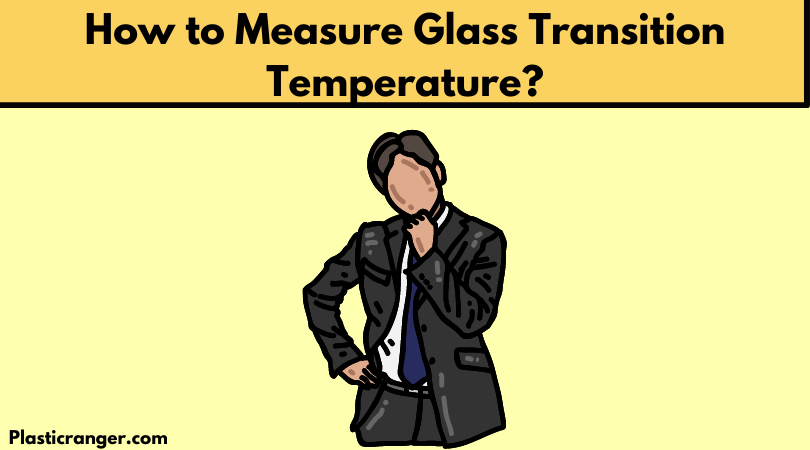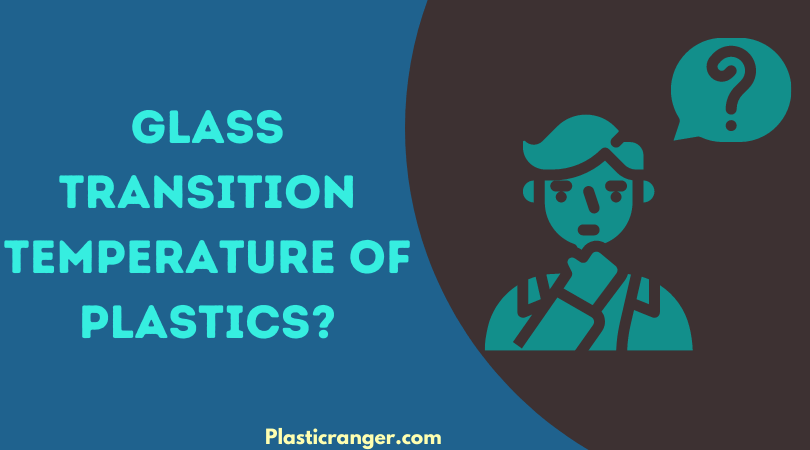Hello people; the physical properties of any polymer have a direct impact on its applicability. Let’s take a look at the Tg of plastic materials.
What is the Glass Transition Temperature of Plastics
When you heat up a specific type of plastic that doesn’t have a clear shape, it turns into a sticky liquid or feels like rubber at a certain temperature. This specific temperature is called the Glass Transition Temperature, or Tg for short. If you cool it back down, that’s the temperature where the plastic starts to get hard, stiff, and more likely to break.
The temperature at which the polymers are heated depends on their chemical structure and thus can be used to identify polymers. For example, a Tg is only exhibited by an amorphous polymer. On the other hand, crystalline polymer shows both Tm and Tg since they contain an amorphous fragment.
The value of glass transition temperature depends on the mobility of the polymer chain, and most synthetic polymer ranges between 170,000 to 500,000.
The transition from glass to a rubber-like state is an integral feature of the polymer attribute, signifying a region of drastic changes in the physical properties such as elasticity and hardness.
The most notable changes in Tg are volume, hardness, elongation to break, and Young Modulus of solids.
Hard and rigid plastics like polystyrene and poly(methyl methacrylate) are used below their glass transition temperatures, meaning that when they are in their glassy state, their Tg values are around 100 °C (212 °F).
On the contrary, Rubber elastomers like polyisobutylene and polyisoprene are used above their Tg when they are in their rubbery state. This is because they’re soft and flexible in that state, and crosslinking intercepts are accessible for their molecules, thus providing rubber with a fixed shape at room temperature.
Quality control, research, and development are The prime applications of determining a polymer’s Tg. Apart from that, it is also used as an integral tool for modifying plastic materials’ physical properties.
The glass transition temp. For the most mainstream thermoplastics is as follows:
The Tg of polypropylene is -20 and -10.
The Tg of polyethylene is -110 as both minimum and maximum values.
Interesting Read – What is the Density of Plastics? | The Complete Guide
How to Measure Glass Transition Temperature?

The most common test method to determine the glass transition temperature of plastics is ASTM E1356. The test method assesses the Tg of materials using differential thermal analysis or scanning calorimetry.
The test methods only apply for amorphous and crystalline materials with stable partial amorphous regions that are stable and do through decomposition in the glass transition region. For both ways, DTA and DSC, their peaks are related to endothermic and exothermic transitions with thermal input and show phase changes.
- Regarding DTA, the difference between the sample and referenced material is observed against temperature or time. While the rise or fall in temperature of the sample in the particular atmosphere is programmed.
- In DSC, the difference in heat flow to a sample and reference material is observed against time or temperature. Thus, the rise or fall in temperature is programmed in a specific atmosphere.
Apart from DTA and DSC, there are several other methods to determine the glass transition temperature of plastic material, such as:
- Thermomechanical analysis
- Thermal expansion measurement
- Micro-heat transfer measurement
- Heat capacity
- Isothermal compressibility
- Specific heat measurements
The Difference Between Amorphous and Crystalline Polymers
Polymers (plastics, elastomers, and rubber) are large macromolecules formed by combining many smaller units called monomers. The molecules can be both amorphous and crystalline.
| Amorphous | Crystalline |
| Amorphous polymers are polymers that are comprised of amorphous regions where molecules are randomly arranged. |
Crystalline or semi-crystalline have a highly ordered or sequenced structure. They are called semi-crystalline as all crystalline plastics have some amorphous material.
|
| Do not have a sharo melkting |
Do you have a sharp melting point
|
| Amorphous polymers are transparent |
Crystalline polymers are opaque/Translucent
|
| Have low shrinkage |
Have high shrinkage
|
| Poor chemcial reisatcne |
Good chemical resistance
|
| High gas permeability |
Low gas permeability
|
Glass Transition Temperature Vs. Melting Temperature
| Tg | Tm |
| The glass transition temperature is the temperature when a hard state of plastic is converted into a sticky or rubbery state |
Melting temperature is the temperature at which solid material is converted into its liquid form
|
| Marks out the transition of glass state into rubber state |
marks out the transition of a solid phase into a liquid phase
|
| It can be observed in amorphous and semi-crystalline compounds |
It can be observed in crystalline compounds
|
| Depends on the chemical structure of the substance |
It depends on the chemical bonding of molecules in the substance and the external pressure
|
The Factors Affecting Tg
Chemical Structure
Molecular Weight – In polymers with a straight-chain structure, an augmentation in molecular weight causes a proportional reduction in chain end concentration. This reduction subsequently decreases the free volume at the end group regions, elevating the material’s glass transition temperature (Tg).
Polar Groups – The presence of polar groups within the polymer increases the intermolecular forces as well as the interaction between different polymer chains. This heightened cohesion level reduces the material’s free volume, which in turn results in an increase in its Tg.
Molecular Structure – Introducing a large, rigid side group into the polymer’s structure increases the Tg. This is mainly because the cumbersome, inflexible side group curtails the overall mobility of the polymer molecules.
Chemical cross-linking – An increment in the level of chemical cross-linking within the polymer hampers molecular movement. This restricted mobility leads to a corresponding decrease in free volume, culminating in a higher Tg for the material.
Water and Moisture Content
When there’s more water or moisture in the material, it forms hydrogen bonds with the long molecules in the polymer. These bonds push the molecules further apart, creating more open space or “free volume” in the material.
Because of this, the temperature at which the material becomes glass-like, called the glass transition temperature (Tg), goes down. For example, HDPE (High-Density Polyethylene) has a Tg of -110 degrees, while for PVC (Polyvinyl Chloride), the Tg is 60 degrees in a hard form.
Addition of Plasticizers
When you add substances called plasticizers to the material, it creates more free volume between the polymer chains. This makes it easier for these long molecules to move around and slide past each other. Because they can move more easily, the Tg of the material becomes lower, meaning it turns glass-like at a lower temperature.
Entropy and Enthalpy Effects
In materials that have a more random, or “amorphous,” structure, the level of disorder—known as entropy—is usually higher than in materials with a neat, “crystalline” structure. If there’s a high level of entropy, the glass transition temperature (Tg) of the material will also be higher.
Pressure and Free Volume
If there’s more pressure around the material, the free volume within it decreases. Less free volume means that the polymer molecules have less room to move. Because they’re more tightly packed, the Tg, or the temperature at which the material becomes glass-like, will go down.
Engaging Read – What is Shore Hardness Scale? | The Complete Guide
Glass Transition Temperature of Mainstream Polymers
| Polymer Name | Minimum Value (°C) | Maximum Value (°C) |
| ABS – Acrylonitrile Butadiene Styrene | 90 | 102 |
| ABS Flame Retardant | 105 | 115 |
| ABS High Heat | 105 | 115 |
| ABS High Impact | 95 | 110 |
| Amorphous TPI, Moderate Heat, Transparent | 247 | 247 |
| Amorphous TPI, Moderate Heat, Transparent (Food Contact Approved) | 247 | 247 |
| Amorphous TPI, Moderate Heat, Transparent (Mold Release grade) | 247 | 247 |
| Amorphous TPI, Moderate Heat, Transparent (Powder form) | 247 | 247 |
| CA – Cellulose Acetate | 100 | 130 |
| CAB – Cellulose Acetate Butyrate | 80 | 120 |
| Cellulose Diacetate-Pearlescent Films | 120 | 120 |
| Cellulose Diacetate-Gloss Film | 120 | 120 |
| Cellulose Diacetate-Integuard Films | 113 | 113 |
| Cellulose Diacetate-Matt Film | 120 | 120 |
| Cellulose Diacetate-Window Patch Film (Food Grade) | 120 | 120 |
| Cellulose Diacetate-Clareflect metalized film | 120 | 120 |
| Cellulose Diacetate-Colored Films | 120 | 120 |
| Cellulose Diacetate-Flame retardant Film | 162 | 162 |
| Cellulose Diacetate-High Slip Film | 120 | 120 |
| Cellulose Diacetate-Semitone Films | 120 | 120 |
| CP – Cellulose Proprionate | 80 | 120 |
| COC – Cyclic Olefin Copolymer | 136 | 180 |
| CPVC – Chlorinated Polyvinyl Chloride | 100 | 110 |
| EVOH – Ethylene Vinyl Alcohol | 15 | 70 |
| HDPE – High-Density Polyethylene | -110 | -110 |
| HIPS – High Impact Polystyrene | 88 | 92 |
| HIPS Flame Retardant V0 | 90 | 90 |
| LCP Glass Fiber-reinforced | 120 | 120 |
| LCP Mineral-filled | 120 | 120 |
| LDPE – Low-Density Polyethylene | -110 | -110 |
| LLDPE – Linear Low-Density Polyethylene | -110 | -110 |
| PA 11 – (Polyamide 11) 30% Glass fiber reinforced | 35 | 45 |
| PA 11, Conductive | 35 | 45 |
| PA 11, Flexible | 35 | 45 |
| PA 11, Rigid | 35 | 45 |
| PA 12 (Polyamide 12), Conductive | 35 | 45 |
| PA 12, Fiber-reinforced | 35 | 45 |
| PA 12, Flexible | 35 | 45 |
| PA 12, Glass Filled | 35 | 45 |
| PA 12, Rigid | 35 | 45 |
| PA 46, 30% Glass Fiber | 75 | 77 |
| PA 6 – Polyamide 6 | 60 | 60 |
| PA 66 – Polyamide 6-6 | 55 | 58 |
| PA 66, 30% Glass Fiber | 50 | 60 |
| PA 66, 30% Mineral filled | 50 | 60 |
| PA 66, Impact Modified, 15-30% Glass Fiber | 50 | 60 |
| Polyamide semi-aromatic | 115 | 170 |
| PAI – Polyamide-Imide | 275 | 275 |
| PAI, 30% Glass Fiber | 275 | 275 |
| PAI, Low Friction | 275 | 275 |
| PAR – Polyarylate | 190 | 190 |
| PBT – Polybutylene Terephthalate | 55 | 65 |
| PC (Polycarbonate) 20-40% Glass Fiber | 150 | 150 |
| PC (Polycarbonate) 20-40% Glass Fiber Flame Retardant | 150 | 150 |
| PC – Polycarbonate, high heat | 160 | 200 |
| PCL – Polycaprolactone | -60 | -60 |
| PE – Polyethylene 30% Glass Fiber | -110 | -110 |
| PEEK – Polyetheretherketone | 140 | 145 |
| PEEK 30% Carbon Fiber-reinforced | 140 | 143 |
| PEEK 30% Glass Fiber-reinforced | 143 | 143 |
| PEI, Mineral Filled | 215 | 215 |
| PEI, 30% Glass Fiber-reinforced | 215 | 215 |
| PEI, Mineral Filled | 215 | 215 |
| PESU – Polyethersulfone | 210 | 230 |
| PESU 10-30% glass fiber | 210 | 230 |
| PET – Polyethylene Terephthalate | 73 | 78 |
| PET, 30% Glass Fiber-reinforced | 56 | 56 |
| PETG – Polyethylene Terephthalate Glycol | 79 | 80 |
| PFA – Perfluoroalkoxy | 90 | 90 |
| PGA – Polyglycolides | 35 | 40 |
| PHB-V (5% valerate) – Poly(hydroxybutyrate – co-valerate) | 3 | 5 |
| PI – Polyimide | 250 | 340 |
| PLA, Fiber Melt Spinning | 55 | 65 |
| PLA, Heat Seal Layer | 52 | 58 |
| PLA, Injection molding | 55 | 60 |
| PLA, Spunbond | 55 | 60 |
| PLA, Stretch blow-molded bottles | 50 | 60 |
| PMMA – Polymethylmethacrylate/Acrylic | 90 | 110 |
| PMMA (Acrylic) High Heat | 100 | 168 |
| PMMA (Acrylic) Impact Modified | 90 | 110 |
| PMP – Polymethylpentene | 20 | 30 |
| PMP 30% Glass Fiber-reinforced | 20 | 30 |
| PMP Mineral Filled | 20 | 30 |
| POM – Polyoxymethylene (Acetal) | -60 | -50 |
| PP – Polypropylene 10-20% Glass Fiber | -20 | -10 |
| PP, 10-40% Mineral Filled | -20 | -10 |
| PP, 10-40% Talc Filled | -20 | -10 |
| PP, 30-40% Glass Fiber-reinforced | -20 | -10 |
| PP (Polypropylene) Copolymer | -20 | -20 |
| PP (Polypropylene) Homopolymer | -10 | -10 |
| PP, Impact Modified | -20 | -20 |
| PPE – Polyphenylene Ether | 100 | 210 |
| PPE, 30% Glass Fiber-reinforced | 100 | 150 |
| PPE, Impact Modified | 128 | 150 |
| PPE, Mineral Filled | 100 | 150 |
| PPS – Polyphenylene Sulfide | 88 | 93 |
| PPS, 20-30% Glass Fiber-reinforced | 88 | 93 |
| PPS, 40% Glass Fiber-reinforced | 88 | 93 |
| PPS, Conductive | 88 | 93 |
| PPS, Glass fiber & Mineral-filled | 88 | 93 |
| PPSU – Polyphenylene Sulfone | 220 | 220 |
| PS (Polystyrene) 30% glass fiber | 90 | 120 |
| PS (Polystyrene) Crystal | 90 | 90 |
| PS, High Heat | 90 | 90 |
| PSU – Polysulfone | 187 | 190 |
| PSU, 30% Glass fiber-reinforced | 187 | 190 |
| PSU Mineral Filled | 187 | 190 |
| PVC (Polyvinyl Chloride), 20% Glass Fiber-reinforced | 60 | 100 |
| PVC, Plasticized | -50 | -5 |
| PVC, Plasticized Filled | -50 | -5 |
| PVC Rigid | 60 | 100 |
| PVDC – Polyvinylidene Chloride | -15 | -15 |
| PVDF – Polyvinylidene Fluoride | -42 | -25 |
| SAN – Styrene Acrylonitrile | 100 | 115 |
| SAN, 20% Glass Fiber-reinforced | 100 | 115 |
| SMA – Styrene Maleic Anhydride | 110 | 115 |
| SMA, 20% Glass Fiber-reinforced | 110 | 115 |
| SMA, Flame Retardant V0 | 110 | 115 |
| SRP – Self-reinforced Polyphenylene | 150 | 168 |
Note – All the data mentioned above in the table is well researched by our team and comes from reliable sources. However, the information is shared strictly for knowledge purposes. Before working with any material, manufacturers should contact their material suppliers for detailed and accurate information about ht material they’re going to work with.
FAQs

Below are the frequently asked questions on polypropylene glass transition temperature, PVC glass transition temperature, and HDPE glass transition temperature.
How does cooling affect glass transition temperature?
The glass transition temperature will increase or lower viscosities as the cooling rate increases.
What is the meaning of transition temperature?
The temperature at which a sudden change of physical properties, such as a change of phase or crystalline structure, or at which a substance becomes superconducting, is called transition temperature.
Do metals have glass transition temperatures?
Like plastics and glasses, metals also have glass transition temperatures, but unlike glasses and plastics, many metals crystallize almost immediately after the glass transition temperature is passed.
What is a rule of thumb relating Tg to TM?
The well-established rule of thumb that Tg ≈ (2/3)Tm already implies the connection between melting and glass transition.
Why does polyethylene have a lower Tg than polystyrene?
Polyethylene has TG because of its high flexibility and absence of side groups. In addition, PE is semi-crystalline due to its relatively simple and consistent structure.
The Conclusion
In conclusion, plastics’ glass transition temperature (Tg) is a vital characteristic that significantly impacts the material’s performance and durability. It influences how the plastic responds to temperature changes, affecting its mechanical properties, such as hardness, strength, and flexibility.
Understanding Tg allows for an informed selection of plastics, tailoring their use to various applications, from everyday products to advanced technologies, ensuring safety, efficiency, and longevity. Mastery of this thermal property is fundamental to advancements in the plastic industry.
Kindly share your reviews in the comment box.
Have a wonderful day.
Quick Navigation

